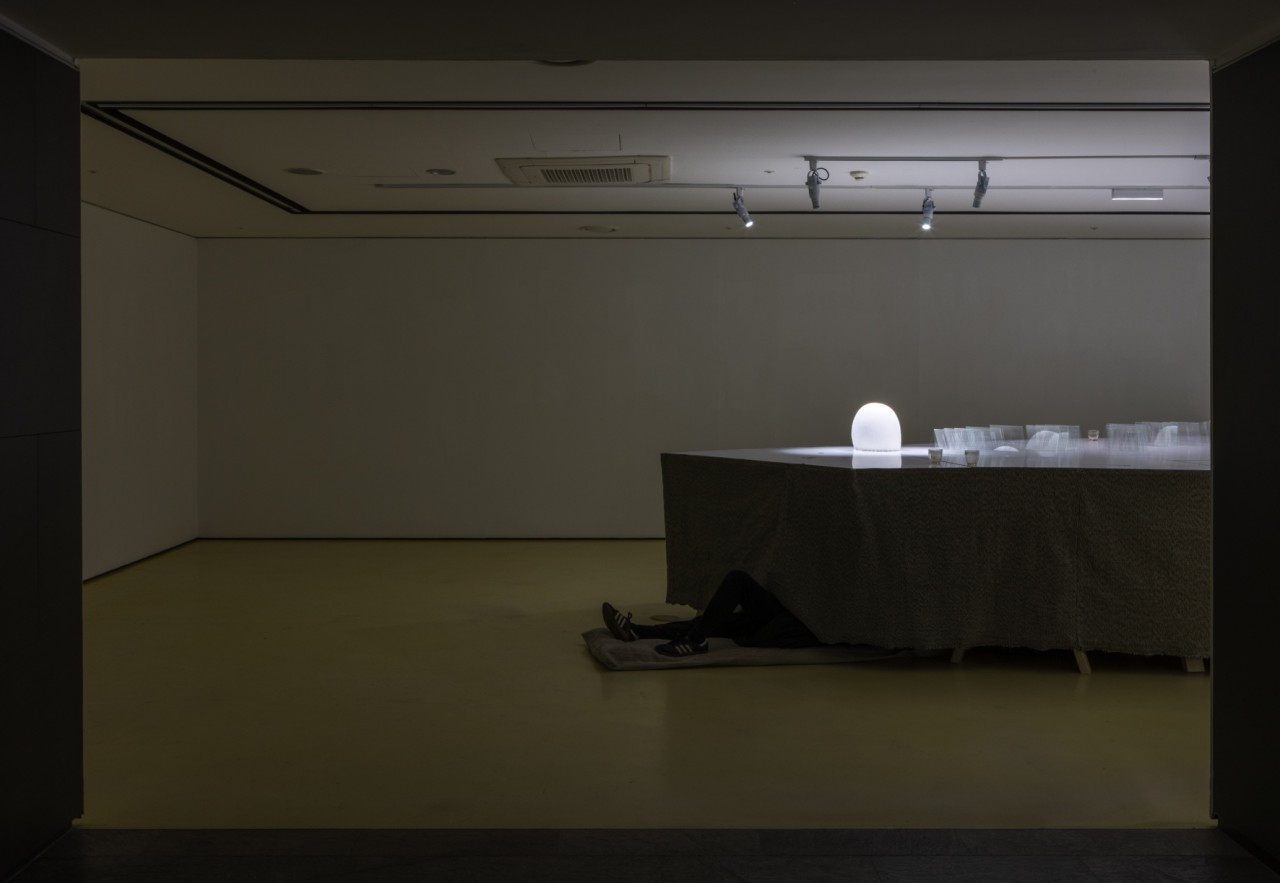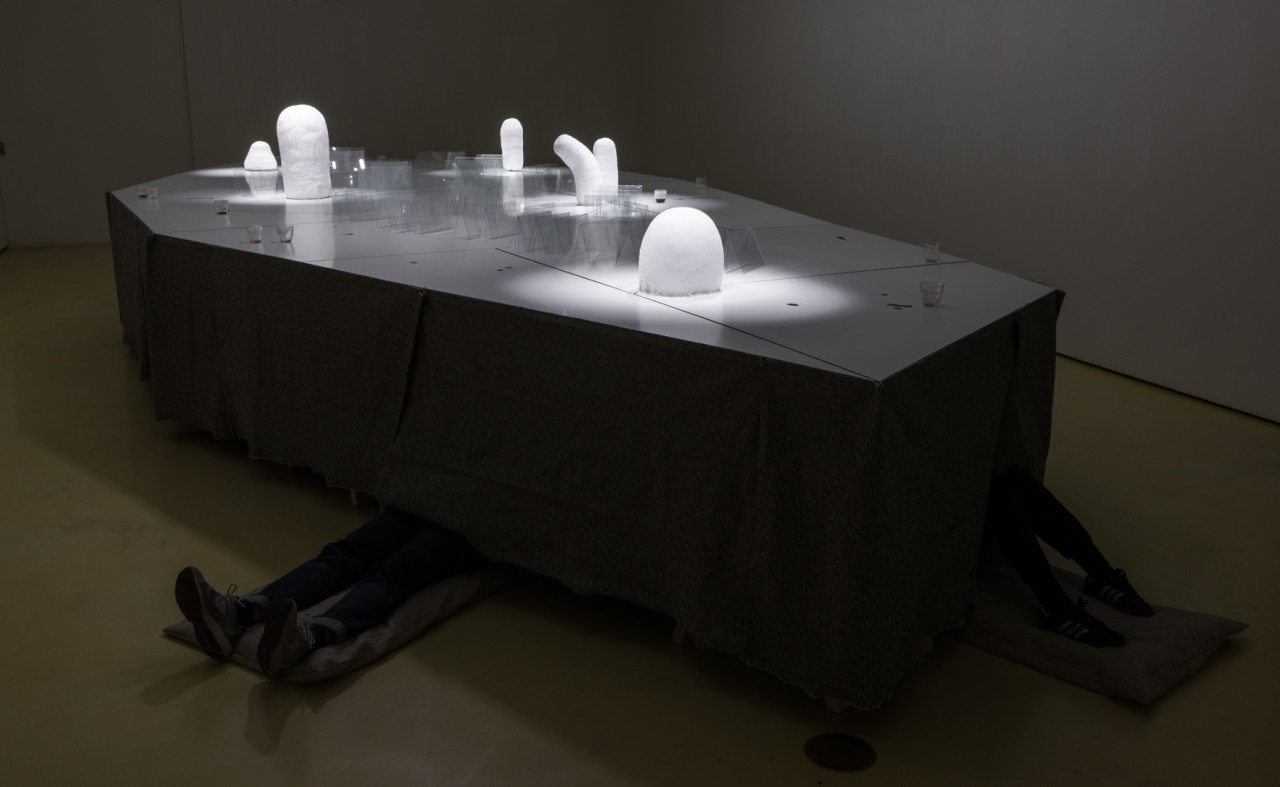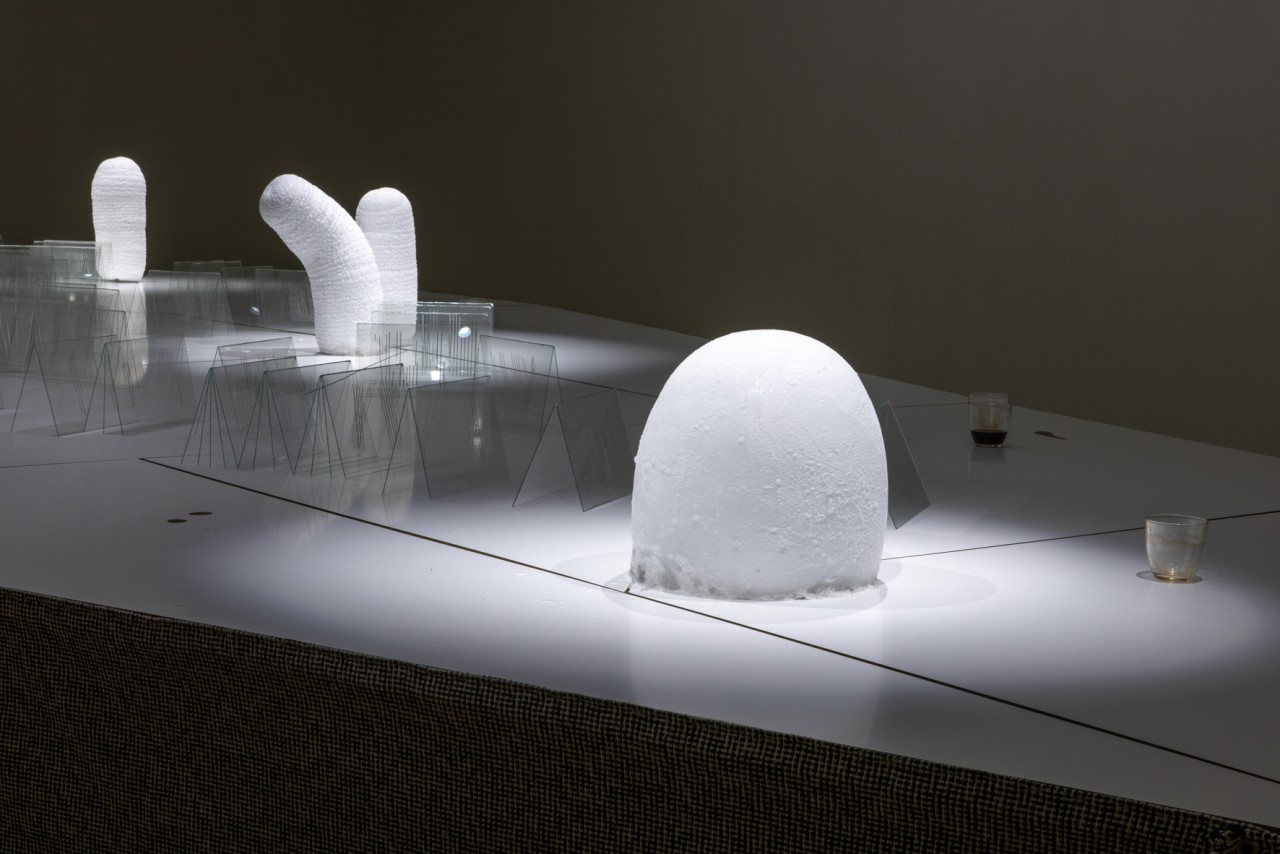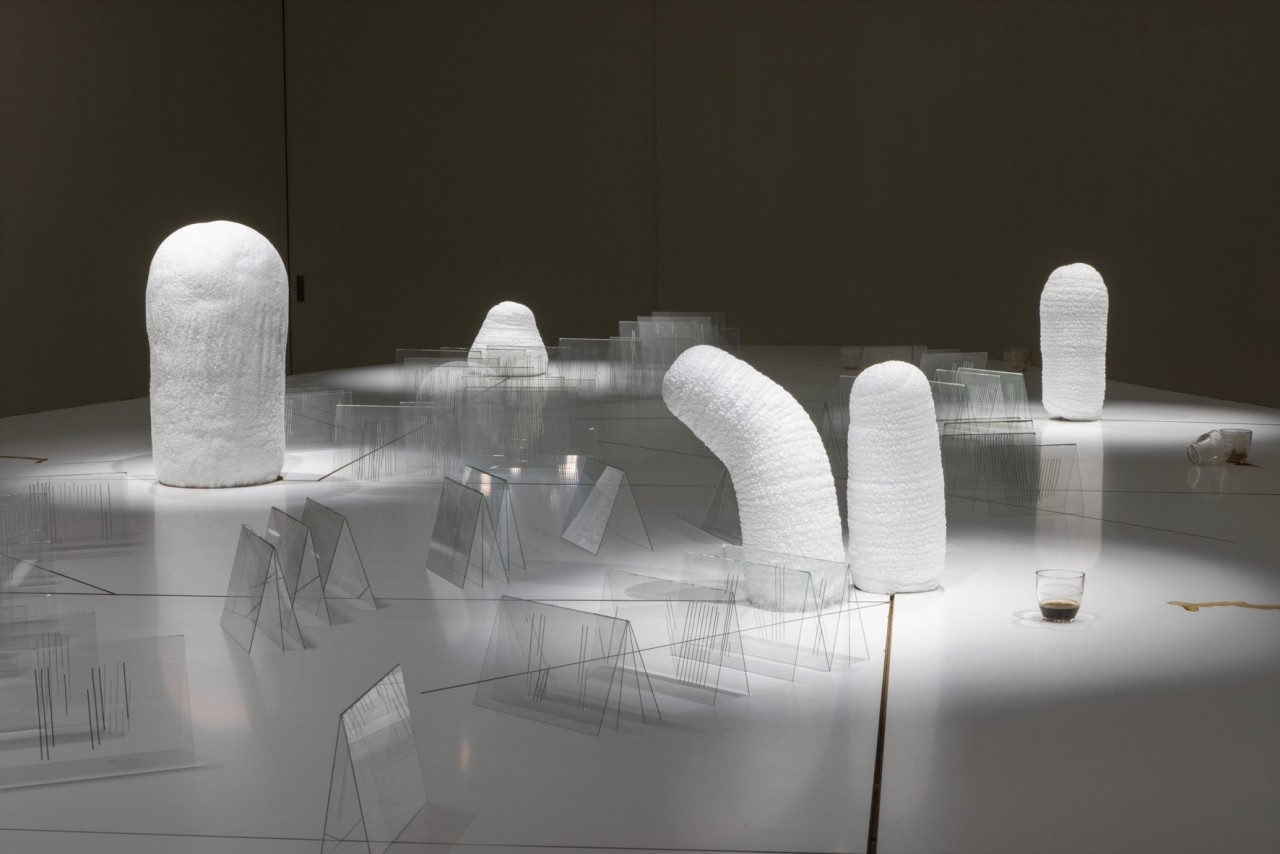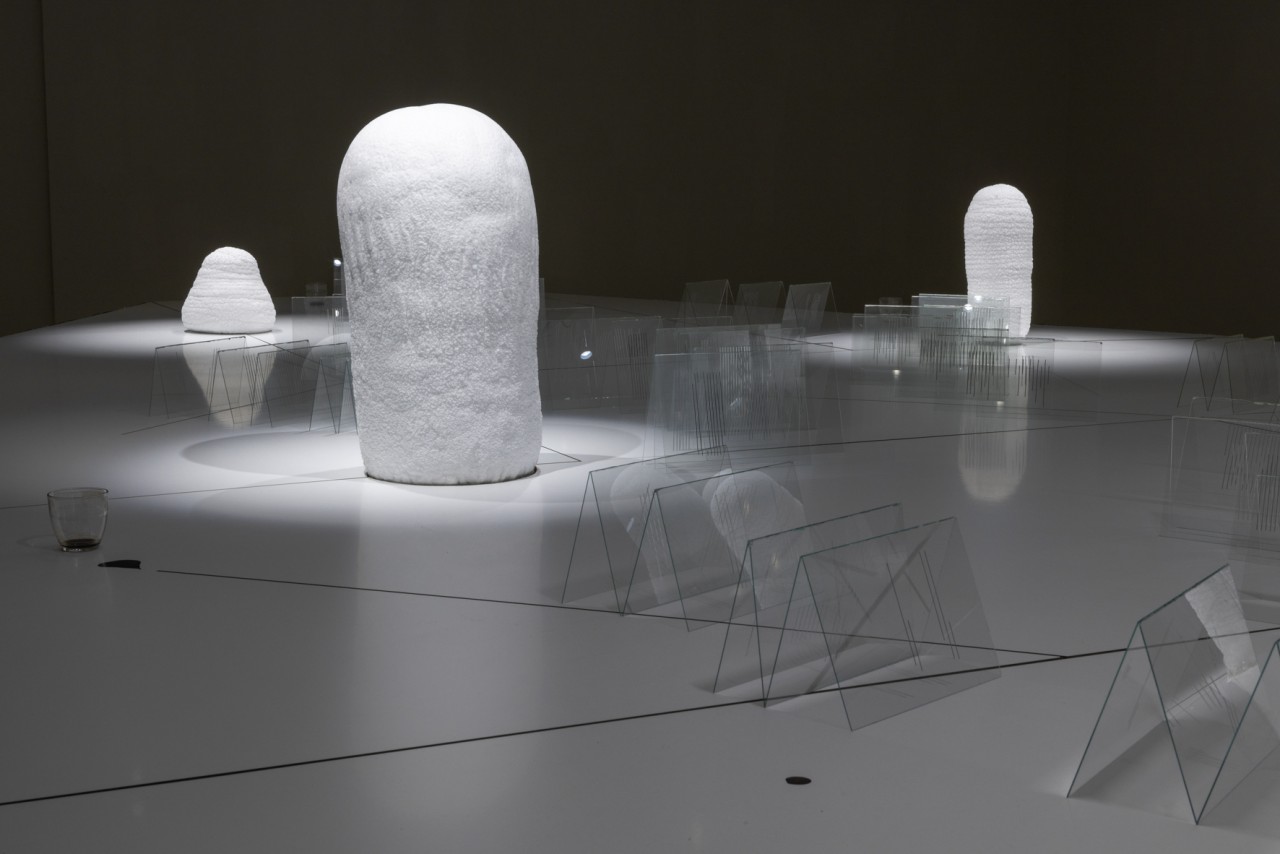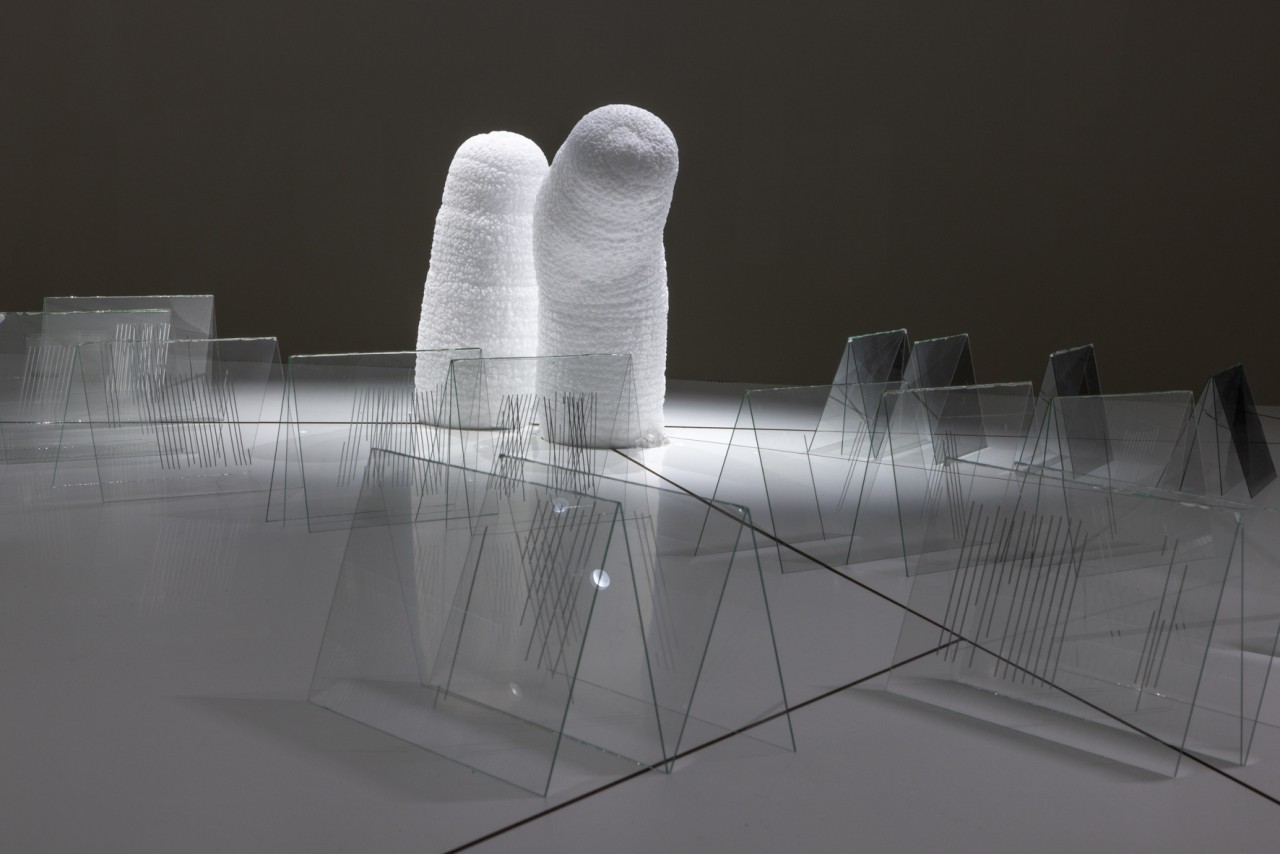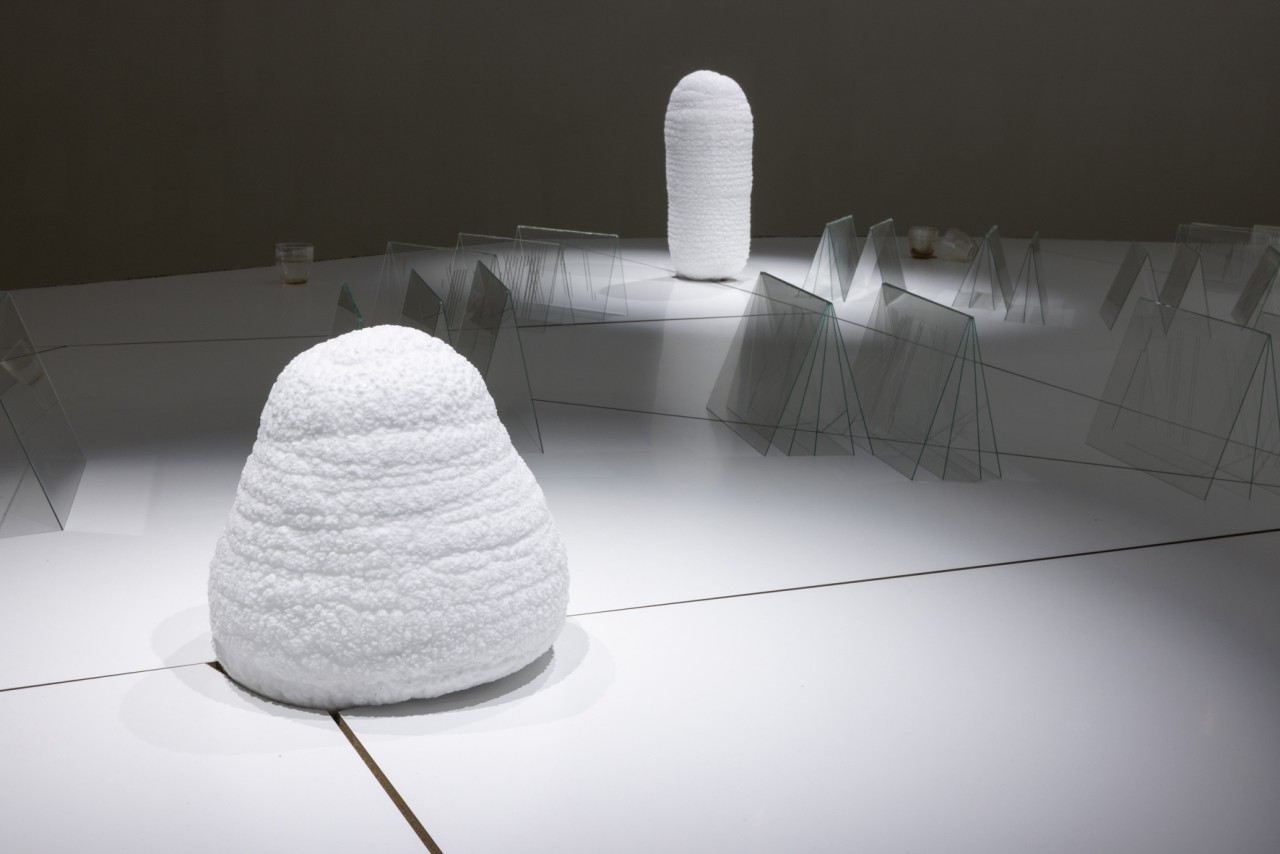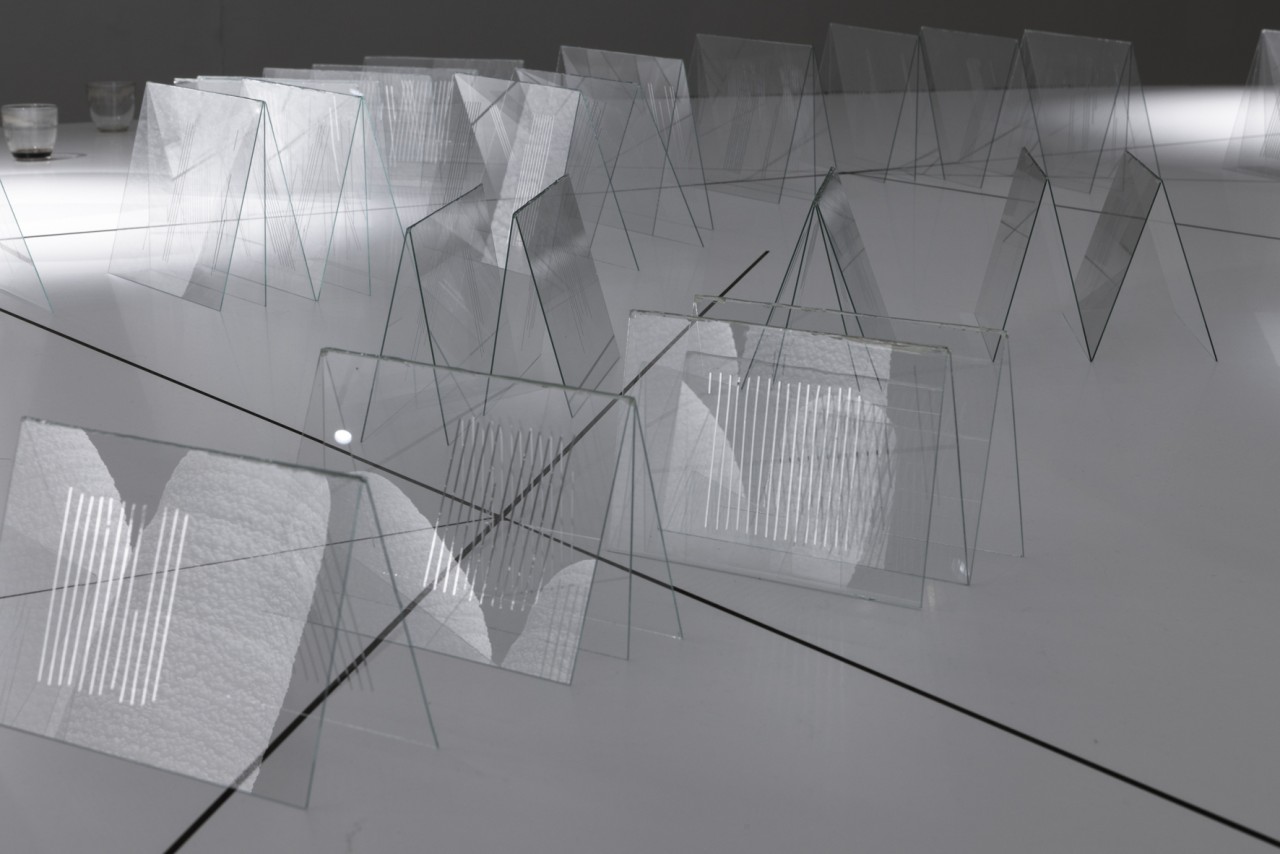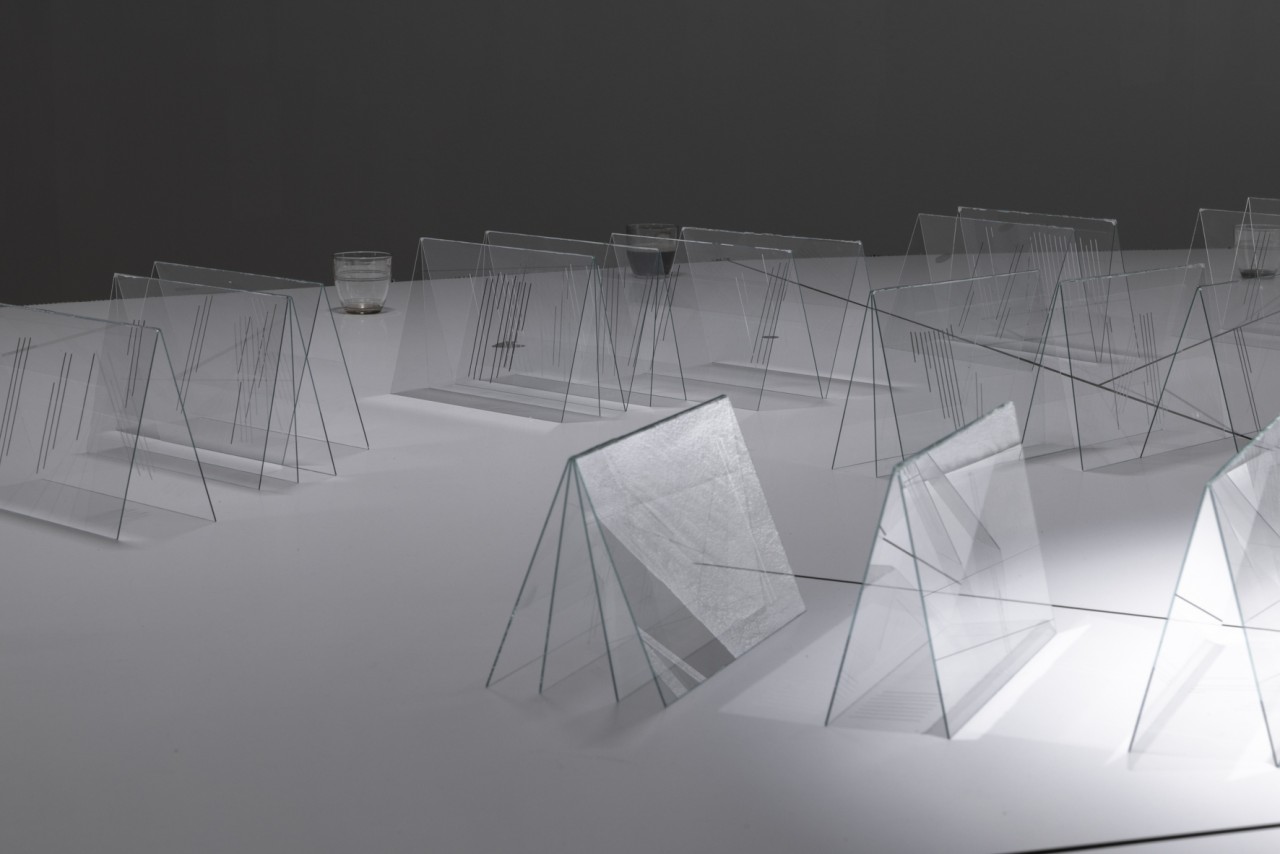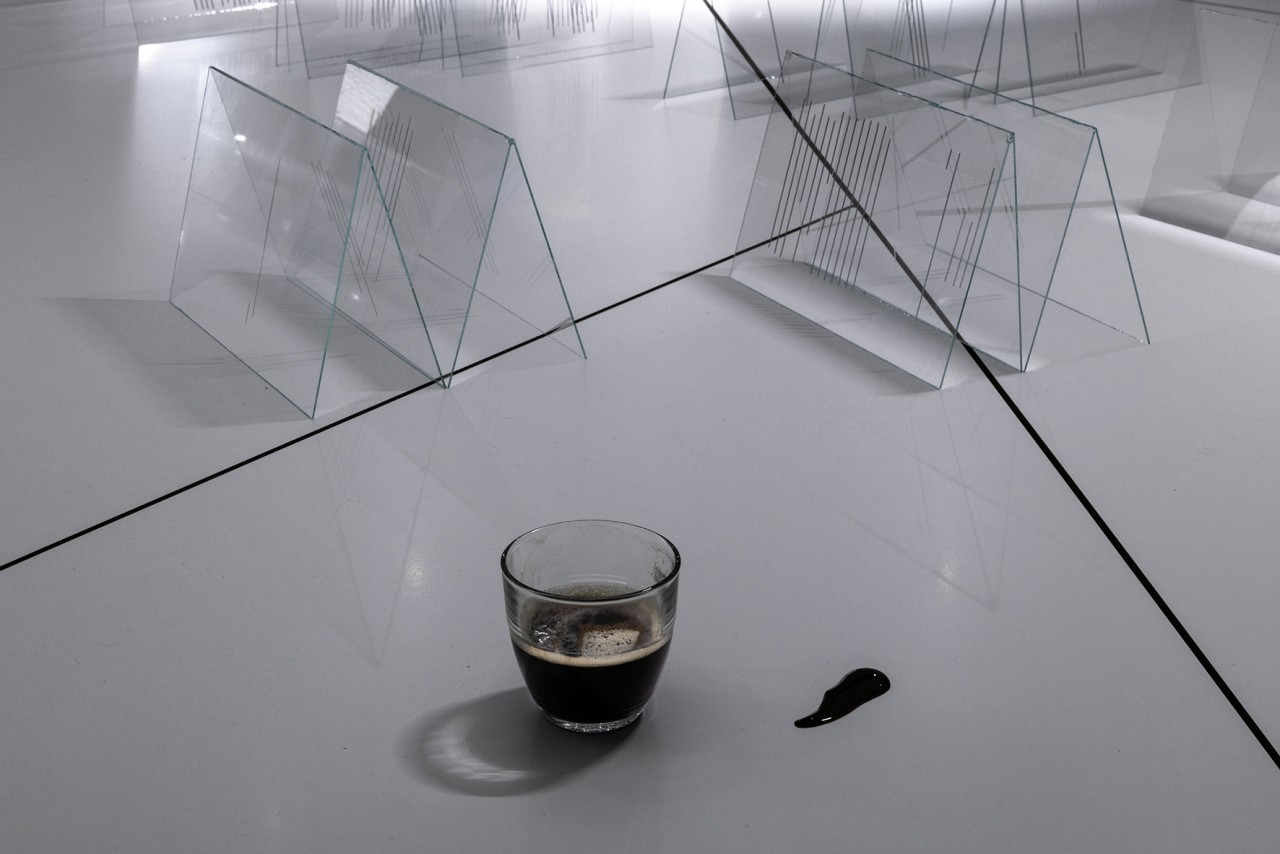Exhibitions
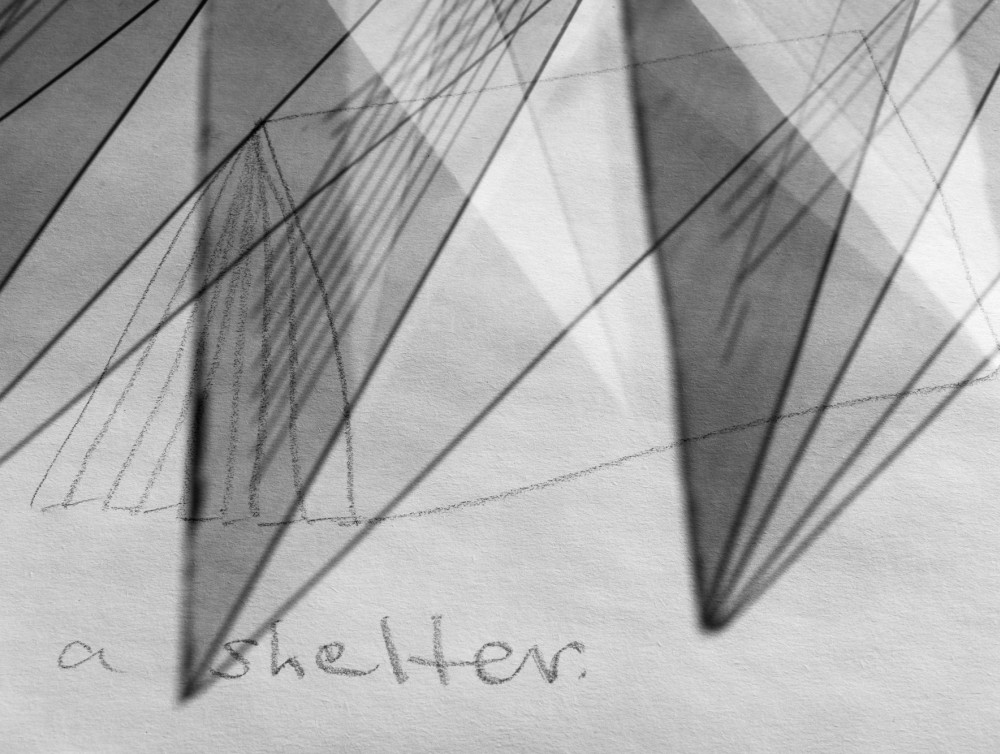
PERIGEE ARTIST #30 박선민
메아리와 서리의 도서관
2023.03.10. FRI ~
2023.04.29. SAT
<현재의 과거가 미래가 되는 일>
신승오 (페리지갤러리 디렉터)
전시장에 들어서기 전에 유리잔에 담긴 따뜻한 커피를 건네받는다. 커피를 내리는 동안 특유의 커피 향기가 코끝을 자극한다. 잔은 투명해 고스란히 커피와 크레마를 보면서, 잔과 마주 닿은 손에 그 온기를 느끼게 해준다. 곧 사라질 크레마, 커피 향과 따뜻함은 이 순간 가장 크게 그 존재감을 드러낸다. 커피는 전시장에 들어서기 전부터 잠잠하던 나의 감각 기관에게 이제 다른 것을 느낄 준비를 하라는 환기의 역할을 부여받은 듯 이 상황에 충실하다. 그대로 들고 들어갈까 아니면 한 모금을 마셔 볼까 고민하면서 전시장에 발을 옮긴다. 눈 앞에 펼쳐진 것은 커다란 책상인데, 그 위에는 얼음덩어리가 여러 형태로 놓여있다. 손으로 만져 보지 않았지만, 머릿속에 각인된 채 인식하는 시각적 차가움과 내 손에 들려 있는 몸으로 느껴지는 따뜻한 커피잔의 대비에 기분이 묘하다. ‘어떤 것이 더 실제적인가?’ 생각하다 이내 나의 눈은 얼음의 차가운 감각에서 벗어나 그 형태가 가진 표면과 윤곽을 따라 시선을 옮기고 있다. 얼음덩어리가 자연스럽게 녹았다 얼기를 반복하면서 만들어진 반질반질하고 울퉁불퉁한 표면과 뒤틀린 형태를 만져보고 싶은 욕망이 일어난다. 이러한 욕망과 더불어 눈에는 보이지 않지만 분명 책상 밑에는 냉각 장치가 있을 것이라는 추측을 하자 어떤 기계음이 간헐적으로 귀에 들어오기 시작한다. 역시 기계장치가 밑에 있다는....
The past of the present becomes the future
Seung Oh Shin (Director of Perigee Gallery)
A cup of warm coffee is passed to me before stepping into the exhibit room. The aroma unique to coffee delights my nose. As the cup is transparent, the coffee and cream are visible, and it warms my hand. The cream, aroma, and warmth of the coffee that will soon disappear reveal their biggest presence in this moment. As if coffee is imposed with the role of reminding my sensory organs of feeling different things, it is quite faithful to this situation. I step into the venue, thinking about whether to take a sip of coffee or enter with it. The view unfolding before my eyes is a huge desk on which lumps of ice in different forms are placed. Although I didn’t touch it with my hands, it seems strange the way its visual coldness contrasts with the warmth of the coffee cup I hold in my hands. I think, “What’s more real?” My eyes follow the surface and outline of a lump of ice, immediately departing from the sensation of its coldness. I have a desire to touch its shiny and twisted form shaped when this ice naturally repeats bein....
신승오 (페리지갤러리 디렉터)
전시장에 들어서기 전에 유리잔에 담긴 따뜻한 커피를 건네받는다. 커피를 내리는 동안 특유의 커피 향기가 코끝을 자극한다. 잔은 투명해 고스란히 커피와 크레마를 보면서, 잔과 마주 닿은 손에 그 온기를 느끼게 해준다. 곧 사라질 크레마, 커피 향과 따뜻함은 이 순간 가장 크게 그 존재감을 드러낸다. 커피는 전시장에 들어서기 전부터 잠잠하던 나의 감각 기관에게 이제 다른 것을 느낄 준비를 하라는 환기의 역할을 부여받은 듯 이 상황에 충실하다. 그대로 들고 들어갈까 아니면 한 모금을 마셔 볼까 고민하면서 전시장에 발을 옮긴다. 눈 앞에 펼쳐진 것은 커다란 책상인데, 그 위에는 얼음덩어리가 여러 형태로 놓여있다. 손으로 만져 보지 않았지만, 머릿속에 각인된 채 인식하는 시각적 차가움과 내 손에 들려 있는 몸으로 느껴지는 따뜻한 커피잔의 대비에 기분이 묘하다. ‘어떤 것이 더 실제적인가?’ 생각하다 이내 나의 눈은 얼음의 차가운 감각에서 벗어나 그 형태가 가진 표면과 윤곽을 따라 시선을 옮기고 있다. 얼음덩어리가 자연스럽게 녹았다 얼기를 반복하면서 만들어진 반질반질하고 울퉁불퉁한 표면과 뒤틀린 형태를 만져보고 싶은 욕망이 일어난다. 이러한 욕망과 더불어 눈에는 보이지 않지만 분명 책상 밑에는 냉각 장치가 있을 것이라는 추측을 하자 어떤 기계음이 간헐적으로 귀에 들어오기 시작한다. 역시 기계장치가 밑에 있다는 확신에 차서 작가의 의도를 발견했다는 만족감에 커피를 한 모금 마셔본다. 아직은 따뜻한 커피의 쓴맛과 액체의 질감이 혀와 목구멍을 자극한다. ‘원래부터 커피 맛은 언제나 모든 사람에게 같은 맛이었을까?’ 그렇다면 우리는 그것을 어떻게 공유했는지 잠시 의심하며 책상의 표면을 자세히 보니 커피가 쏟아졌거나 흘린 흔적들이 보인다. 또다시 시선을 주변으로 돌리니 내가 들고 있는 것과 같은 커피잔이 여기저기에 아무렇게나 놓여 있다. 내가 여기 있기 전에 이미 방문한 타인에 대한 흔적을 인식하고 나니 그들은 어떻게 이 작품을 보고 느꼈을까 궁금해진다.
이러한 새로운 인식은 나를 갑자기 관객이라는 수동적인 태도에서 어떤 흔적을 통해 무엇인가를 추적하는 사냥꾼 혹은 탐험가와 같은 적극적이고 자발적인 태도로 전환하게 만든다. 또 무엇이 책상에 있는지 날카로운 눈으로 살펴본다. 아까부터 존재감을 드러내고 있었던 삼각형 형태의 유리판이 얼음 사이 사이에 놓여 있다. 유리판에는 직선이 나타나는데, 이전에 작가에게 얼핏 들은 적 있는 작품이었다. 작가는 자신이 읽었던 책에서 중요하게 생각된 문장이나 단어에 밑줄을 긋는데 여기서 글을 제외하고 선만 옮겨 온 것이다. 그런데 그것이 놓인 설치의 형태에 대해서는 정확히 들은 바가 없었다. 단지 세로로 눕혀져 있는 유리판이 줄지어 놓이며 중첩되는 수직선들의 형태가 흥미로워서 유심히 투명한 유리와 선을 보면서 설치된 방식의 의미에 대해 추측해 본다. 단순히 책을 엎어놓은 것 같기도 하고, A형 텐트 같기도 한 그 모습에 포스터 이미지에서 ‘a shelter’라는 단어를 본 것 같았지만 다른 것이 이내 눈에 들어와 그 의미의 본질을 추적하다 말고 그대로 남겨둔다. 유리판 옆을 자세히 보니 책상에도 여러 직선이 보인다. 어떤 방향성과 경계를 구분하는 제각각의 길이도 방향도 다른 선을 보는 눈이 갑자기 갈 곳을 잃고 허둥댄다. 비정형적인 책상의 모양이 직선들과 뒤엉켜 작가가 이 책상 안에서 우리의 시선이 길을 잃게 만드는 것이 목적이 아닐까 하는 의심이 든다. 아니나 다를까 이런 생각이 들 때 더 자세히 보기 위해 책상에 다가서다 부딪쳐 커피를 책상 위에 흘렸다. ‘이런 낭패다.’ 그런데 불현듯 아까 본 커피 자국이 떠오른다. ‘이것도 나 같은 사람이 그런 것일까?’ 하는 생각이 드니 보이지 않는 존재와 동일한 경험을 공유하는 것 같아 묘하게 안심이 되고 이내 즐거워져서 흘린 커피는 잊힌다. 이젠 처음부터 신경 쓰였던 책상 아래 커튼 안이 궁금해졌다. 왠지 이전의 그의 작업에서 책상 안으로 눕게 만들었던 작품이 떠올라 서둘러 몇 군데 커튼을 열어보니 역시나 누울 수 있는 자리와 헤드폰이 준비되어 있다. 이전에 한 번 경험해 봤기에 아무런 의심 없이 헤드폰을 쓰고 눕는다. 그런데 눈에 보이는 것은 없고, 음악이 흘러나오니 시각에 의존하지 말라는 뜻인가 싶어 자연스레 눈을 감는다. 무엇인가 타는 소리, 책장 넘기는 소리, 열대 우림의 소리 같은 것이 음악에 뒤섞여 들린다. 이 음악과 함께 몸은 조용히 누워있지만, 책상 아래에서 작동하는 냉각장치에서 나오는 소리와 진동, 약간의 온기, 바람이 느껴진다. 머릿속에는 방금 책상 위에서 보았던 다양한 설치 오브제와 내가 눕기까지 했었던 행위들이 복잡하게 뒤엉킨다. 그러다 점점 복잡하게 얽히는 생각과 감각들이 어느 순간 사라진다. ‘살짝 잠이 들었나 보다.’ 갑자기 정신을 차리고 일어나서 여전히 손에 들고 있는 반쯤 마시다 식어버린 잔을 책상 어디엔가 올려놓고 본능적으로 핸드폰 카메라로 이곳저곳을 무심히 여러 번 찍는다. ‘전시 잘 봤네!’ 하며 전시장을 나서는 순간 이내 다른 생각이 그 자리를 차지한다.
*
위의 글은 필자가 《메아리와 서리의 도서관》이 설치되기 전에 작가와 나누었던 전시에 대한 대화를 총합한 것으로 온전히 작품이 설치되기 전의 결정되지 않은 미래에 대한 이야기이다. 이것은 완벽한 허구이지만 아마도 관객은 전시장에서 이 글과 유사한 위와 아래, 수평과 수직 그리고 곡선의 서로의 다른 형태와 리듬을 가지고 있는 시공간을 만나게 될 것이다. 이 글이 실제의 현실과 어떤 차이와 간격을 가지게 될 것인가도 궁금하지만 그보다는 위에서 언급한 여러 장치는 규칙적인 조화를 이루기보다는 충돌하고 서로를 밀어내며 전면에 나타나기 위해 혼란스러운 경쟁을 한다는 점에 주목해야 한다. 이러한 구성은 그의 작업을 어떤 특정한 체계로 연결되는 구조를 보여주는 것이 아니라 복잡성이 교차하는 시공간에서 서로 분리된 채 다양한 것이 창발할 수 있는 계기를 제공하는 세계를 구현해 놓은 것처럼 보이게 만든다. 그렇다면 그가 말하는 《메아리와 서리의 도서관》은 무엇인가? 도서관이라는 상징적 공간은 불균질한 복수의 시간이 교차하는 공간이며 서로 다른 속도와 다른 지속성을 가진 것들의 집합체이다. 하지만 우리는 여기에 사용자가 쉽고 편리하게 정보를 획득하도록 분류와 정리를 통해 색인을 만들어 고정된 사용법을 적용함으로써 다층적인 정보의 층위 사이를 자유롭게 휘저으며 얻게 되는 우연적 만남의 계기를 축소하고 있다. 그렇기에 그가 추구하는 미래의 도서관은 명확한 길로 인도하는 항구적인 도서관이 아니라 계속해서 길을 잃고 헤매고 끊임없이 무너져 내리고 새로 만들어지는 도서관이다. 작가가 상상하는 새로운 도서관과 유사하게 우리 앞에 놓인 현실은 원시적 밀림과 같이 한치의 앞도 예상하기 힘든 현실의 혼돈과 무질서한 세계로 보이지만, 용감히 그 속을 파고들어 탐험한다면 숨겨져 있는 어떤 의미를 발견할 수 있는 풍부한 공간이다. 그렇지만 이렇게 새로운 길을 만들어 내기 위해서는 탐험의 경험만으로는 부족하며, 도서관처럼 어떤 것에 대해 깊게 정주하여 탐구하는 지식의 시간 또한 필요하다. 따라서 그가 이러한 작품을 통해 주목하는 것은 인류가 지금까지 말과 글을 통해 쌓아나가고 있는 단단한 지식의 구축과 인간의 감각이나 감정과 같은 본성을 구분하는 이분법적인 경계를 넘어서고자 하는 관점이다. 그가 상상하는 미래의 도서관은 이 모든 것들이 하나로 뒤섞여 다양한 감각으로 경험하게 되는 공간이며, 그것이 미래의 인류를 위한 안식처를 제공할 것으로 기대한다. 그러기 위해서는 결국 우리는 고정된 체계와 규칙을 자유롭게 넘나들어야 한다. 그것이 작가에게는 탐험을 통한 경험과 탐구를 통한 지식의 획득 어느 한쪽으로만 치우치지 않고 그 사이를 반복해서 미끄러지듯이 걷는 일이다.
이를 위해 그는 책을 읽고 인터넷을 통해 다양한 자료를 수집하고 연구하는 행위를 반복적으로 수행하고 있다. 그의 이러한 행위는 우리가 느끼거나 인식하지 못하는 서로 이질적인 것들이 상호작용하는 흐름을 만들어 내는 것, 자신이 행하는 조형적인 과정을 되돌아보는 것, 어떤 대상과 이야기 속에 잠재된 것을 발견하는 것, 잊힌 과거의 것을 현재에 다시 들춰내는 일 그리고 이러한 무용한 일을 반복하며 어떤 징후를 발견하는 일 등등이다. 물론 그가 얻는 정보는 언어에서 시작되지만, 작가에 의해 이내 사물과 이미지로 옮겨가게 된다. 이러한 과정을 결과로 보여주는 것이 그에게는 시각 예술인데, 이는 우리에게 끊임없이 우회로를 제공하며, 위에서 필자가 전시를 관람하는 방식과 같이 시작과 끝이 반복되는 과잉, 그리고 그리고 그리고 그리고 그리고를 순환시키는 행위에 기인한다. 이렇게 그의 작품은 어떤 대상의 흔적을 따라가면서 또 다른 흔적을 남긴다. 그리고 이러한 이질적인 것들이 이어져 나가며 발생하는 전환과 환기의 분절점을 통해 새로운 감각의 시공간을 획득하게 해준다. 이는 파편적인 정보를 연결해 나가는 동시에 얻게 되는 감각의 원초적인 기억이다. 정리해보자면 그가 다루는 것은 인류가 과거와 현재에 살아가면서 해결하고자 했던 물리적, 문화적, 정신적 삶의 근본적인 문제이다. 여전히 우리가 수많은 갈등, 욕망, 투쟁을 겪으면서 살아가고 있는 것처럼 이러한 문제들은 오래전부터 지금까지 우리에게 영향을 끼치고 있다. 그는 이러한 관념과 현재 우리의 육체적 실존이 충돌하며 발생하는 어긋남이 어떤 방식으로 접촉하고 해제되는지 보여준다. 인간의 역사와 함께해온 관념들은 일시적으로 잠재되어 있다가 어느 순간 특별한 분절점을 만나게 되면 솟구쳐 올라 그 존재를 다시 드러낸다. 따라서 이번 작업의 제목인 메아리는 몸으로 경험하게 되는 실존에 대한 반향이며, 서리는 관념적인 것들이 응축된 순간을 기록하는 언어와 같은 것이 서로 밀착되어 있음을 은유적으로 보여준다.
그렇지만 우리는 여전히 시각 예술뿐만 아니라 모든 현상에서 명확하게 무엇인가를 규명하기 위해 표면의 층위와 내면의 층위를 구분해서 보려 한다. 하지만 우리가 보게 되는 형태와는 다르게 작용하는 힘, 예를 들면 무의식이나 시간의 추상성과 같은 것은 구분의 경계를 불명확하게 만든다. 그렇기에 이번 작품에서는 그가 책상의 위아래에 제시하는 모든 정보가 휘발된 상징적인 장치는 우리에게 어떤 공간의 의미를 시각적으로 드러내기보다는 보이지 않는 시간의 조형성과 그 구조를 온몸으로 경험하기 위한 도구였음을 알 수 있다. 이렇게 그의 책상은 시작과 끝이 계속해서 반복되는 생명력이 넘치는 시공간으로 우리에게 서로 다른 방향을 향하는 복잡한 감각들을 경험하게 만든다. 이러한 다채롭고 우연적인 세상의 법칙을 이해하고자 한다면 우리는 일방적인 공식과 보편적인 체계를 넘어서고자 해야 한다. 그러기 위해 이 전시에서 작가에 의해 제공되는 개별의 요소와 같은 독립된 하나의 매개체가 서로에게 매개되어 다양한 상호작용을 일으킬 수 있는 사고와 행위가 중요하다. 그것이 설사 어떤 사고의 맥락을 논리적으로 풀어내는 데에 장애물이라 하더라도 또 다른 가능성을 열어주는 이행의 과정 그 자체가 매개의 도구가 될 수 있어야 한다. 이러한 매개의 과정으로 인해 비로소 우리가 보편적으로 살고 있는 미래로만 일직선으로 흘러가는 시간이 서로가 서로에게 침투하고 영향을 받는 전혀 다른 시간의 구조로 변모하게 될 것이다. 이는 그의 작품처럼 자유롭지만 자유롭지 못한, 규칙과 형식이 있어 보이지만 존재하지 않는 규정할 수 없는 풍경에 부유하는 시간이다. 이렇게 그는 지금, 이 순간에도 계속해서 무엇을 쌓아 올리면서 동시에 무너뜨리고 있다. 이 시간은 그의 전시 제목처럼 메아리로 서리로 이내 나타났다 휘발되는 것이고 아직 경험하지 않은 전시에 대한 글과 같다. 이들은 혼돈에서 시작되어 다시 혼돈으로 돌아가겠지만 그 사이를 걸으면서 우리가 감지한 것들은 계속해서 잔존하게 될 것이다. 그렇다면 그가 탐구하고 탐험한 과정인 과거의 시간을 현재의 시간인 전시로 보여주는 행위는 결국 아무것도 결정되지 않은 미래를 살짝 열어보는 일이 아니었을까?
Seung Oh Shin (Director of Perigee Gallery)
A cup of warm coffee is passed to me before stepping into the exhibit room. The aroma unique to coffee delights my nose. As the cup is transparent, the coffee and cream are visible, and it warms my hand. The cream, aroma, and warmth of the coffee that will soon disappear reveal their biggest presence in this moment. As if coffee is imposed with the role of reminding my sensory organs of feeling different things, it is quite faithful to this situation. I step into the venue, thinking about whether to take a sip of coffee or enter with it. The view unfolding before my eyes is a huge desk on which lumps of ice in different forms are placed. Although I didn’t touch it with my hands, it seems strange the way its visual coldness contrasts with the warmth of the coffee cup I hold in my hands. I think, “What’s more real?” My eyes follow the surface and outline of a lump of ice, immediately departing from the sensation of its coldness. I have a desire to touch its shiny and twisted form shaped when this ice naturally repeats being melted and frozen. As I guess that a cooling device is apparently under the desk, invisible though, I begin hearing some machine sound intermittently. With certainty, I take a sip of coffee, satisfied with the fact that I discovered the artist’s purpose. My tongue and throat are stimulated by the bitter taste of the coffee that is still warm. “Was coffee flavor always the same for everyone?” I doubt for a moment how we could share this. Looking closely enables me to find marks made by coffee spilled on the desk. Looking around at my surroundings, I find coffee cups just like mine carelessly placed here and there. When I am conscious of someone who was here before me, I wonder how they felt about this work.
This new perception has me shift from the passive attitude of a viewer to the active, spontaneous attitude of a hunter or an explorer who chases something through some traces. I examine what is on the desk with keen eyes. The triangular glass panels with their own presence are in between lumps of ice. Visible in this work I heard superficially from the artist is the straight lines. Sunmin Park used to draw a line under the important sentences or words of which she adopted only underlines but sentences or words. By the way, I have never heard of how those glass panels should be set. I try to guess the meaning of setting the glass panels, while carefully seeing the transparent glass and lines, since the overlapped vertical lines engendered by setting the glass panels vertically are of particular interest. These look like a book put face down or an A-shaped tent. I think I have seen the words ‘a shelter’ in a poster, but I stop chasing the nature of its meaning, as other things came into sight. In a close-up view, a number of straight lines are seen on the desk. Looking at the lines of different lengths going in different directions is flustering. I doubt that the artist intended to make me feel lost within the desk when the desk’s atypical shape is entwined with straight lines. Sure enough, I spilled my coffee as I drew near to the desk for a closer look. “Oh, that’s terrible.” I suddenly conjure up the coffee stains I noted a while ago. I am strangely relieved to have an impression that “this was also done by a person like me” and I seem to share the same experience with an unseen being. I become more amused and so forget the spilled coffee. I start wondering what is inside the curtains under the desk. As her previous work that allowed one to lie down on a desk comes to mind, I hurriedly draw the curtains and find a bed to lie in and headphones. Because I have experienced this before, I lie down without trepidation and put on the headphones. I understand this work is perhaps not meant to rely on the sense of sight because nothing is seen and only the music flows out. So, I naturally close my eyes. I hear a mixture of the crackling of something burning, the sound of turning pages, and a tropical rain forest with sound. Although I lie down calmly, I can hear sound from a cooling device under the desk, and feel some vibration, warmth, and wind. The diversity of installed objects I saw on the desk are tangled up with actions I did before I lied down. And then, some intricately entwined ideas and senses suddenly disappear. “I seemed to doze off for a while.” Recovering my consciousness, I stand up and put down the cup of coffee I had half on the desk. I instinctively and indifferently take pictures with my cell phone. The moment I come out of the venue, other ideas immediately occupy this site.
*
The above is a summary of my conversation with the artist about the exhibition before The Library of Echo and Frost was installed. This is the story of an undetermined future before this work was set perfectly. This story is completely fictional, but the viewer will come across a space-time with top and bottom, horizontal and vertical lines, and different curves and rhythms in the venue as this essay has described. I wonder what differences and gaps this essay may have from the actual reality. Above all else, we have to take note of the fact that the diverse devices mentioned above compete to come to the front by clashing or pushing each other back rather than trying to be in harmony. This composition makes her work look like it was incarnated in a world in which a wide array of things can be invented and created in an intricately intersecting space-time. If so, what is The Library of Echo and Frost? A library is a symbolic space where heterogeneous plural times cross as well as a collection of things with different velocities and sustainabilities. Her library, however, is a reduction of the opportunities to experience multilayered information we are able to gain through the indexes made by classification and arrangement. The future library she seeks is thus not a permanent library that leads to an apparent path but a library that loses its way and collapses consistently, and is newly built. Although the reality we face looks like a disorderly world that is unpredictable, as in a primeval forest, it is a rich space where we can discover hidden meanings in a new library, if we bravely explore this. All the same, an experience of exploration is not enough to create a new path in this way: we need more time to settle in something like a library and seek knowledge eagerly. What she notes through such work is a perspective to move beyond the dichotomous boundary between solid knowledge amassed by words and texts and human nature like senses and emotions. The future library she conceives is a space in which all of this is mingled and we experience it with our diverse senses. This is anticipated to offer a haven for future humankind. In order to do this, we need to freely go beyond all fixed rules and systems. This is something between the acquisition of experience through exploration and knowledge through research without being partial to either.
To do this, Park has carried out acts such as reading books and collecting and studying a variety of sources through the Internet. These acts create some flow in which things foreign to one another we cannot feel or perceive interact; looking back on the modeling process she has taken; discovering things that are latent in some object or narrative; disclosing forgotten past things in the present; and finding some signs while doing such useless work. A snippet of information she acquired first was of course couched in a language, but it was transferred to an object or an image. To the artist, it is the visual arts that showcase this process. This constantly provides us with a roundabout way, springing from a plethora of beginnings and endings like the way in which I viewed the exhibition mentioned above. Like this, her work leaves another trace while following an object’s trace. Her work enables us to gain the space-time of a new sense through a segmental point of conversion and evocation generated by a connection of such heterogeneous things. This is the primal memory our senses have when connecting the snippets of information. To sum up, what she deals with is the elemental problem of physical, cultural, and spiritual life mankind has tried to solve since ancient times. Just as we are going through innumerable conflicts, desires, and struggles, such problems have long since had an effect on us. Park shows how the dislocation arising from a collision between such a notion and our physical existence is generated or dissolved. A notion that has been in human history is temporarily latent but suddenly reveals its presence when at a particular turning point. Thus, the echo in this work’s title is a resonance to the existence experienced by the body whereas the frost is a metaphor for something notional couched in languages.
And yet, we still try to distinguish between the internal and external layers to clarify something in every phenomenon. The forces differently working from what we see, to take an instance, such as unconsciousness and abstractness of time blur this distinction. Therefore, we realize that the symbolic devices she presents on and under the desk in this work, from which all information volatilizes, are those to experience an invisible time’s modeling quality rather than visually disclosing some space’s meaning. As such, her desk is a space-time full of vitality in which beginning and end are in an endless cycle. It has us experience complex sensations from different directions. If we intend to grasp the laws of such a multifarious, accidental world, we have to move beyond general formulae and universal systems. For this, what matters in this exhibition are thoughts and actions that bring about various interactions as an independent medium like her work’s individual elements that are mediated by each other. Even if this is an obstacle that precludes us from interpreting the context of some thought logically, the process of carrying it out should be a vehicle for intermediation. The fabric of time flowing only linearly to the future becomes a different time structure due to this process of intermediation. It is a floating time in a nonexistent and indeterminate landscape that seems to be as free as her work, and that seems to have rules and forms. Like this, she is continuously accumulating and demolishing something simultaneously even at this very minute. As in her exhibition title, this time appears and disappears as echoes and frost that is like the text pertaining to a not yet experienced exhibition. They start from and return to a confusion, but what we sensed, when walking between them, will be continuously extant. If so, didn’t the act of displaying the time of the past she explored as the present time of an exhibition unlock the future in which nothing is determined?



